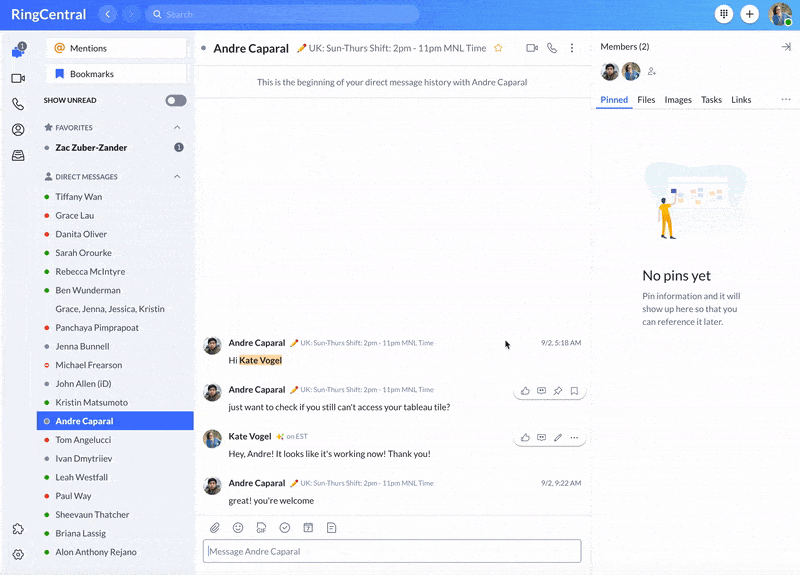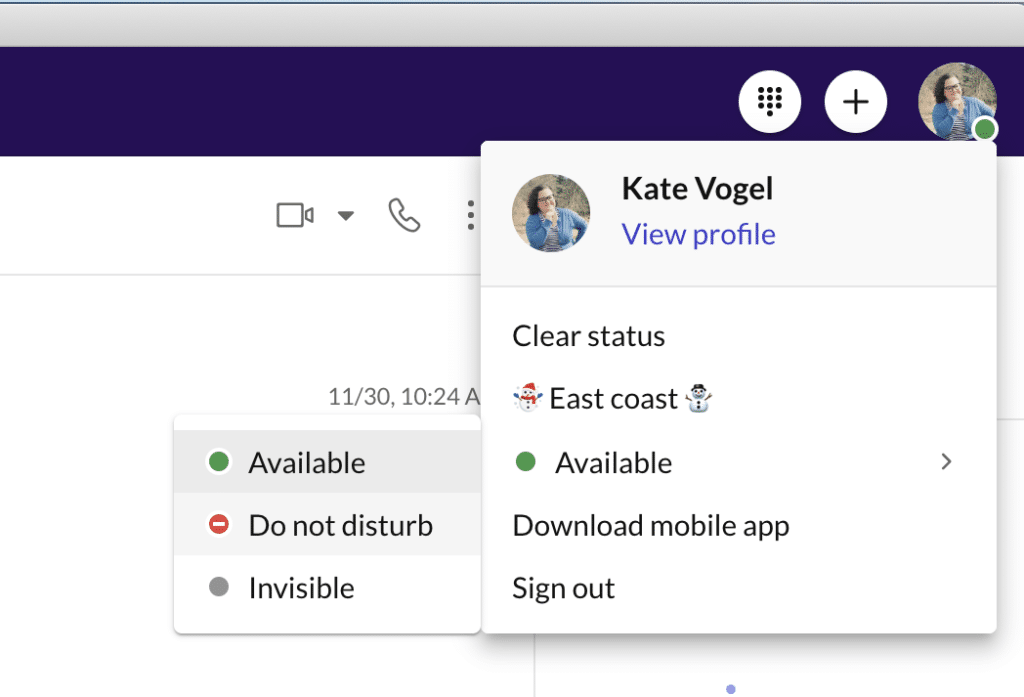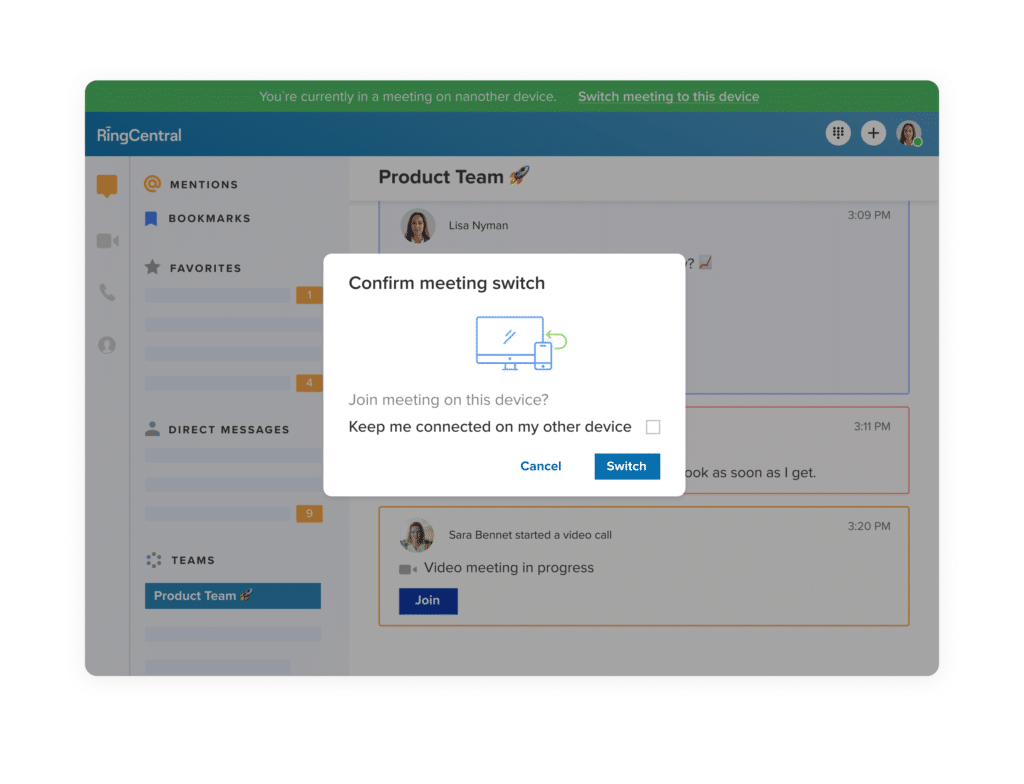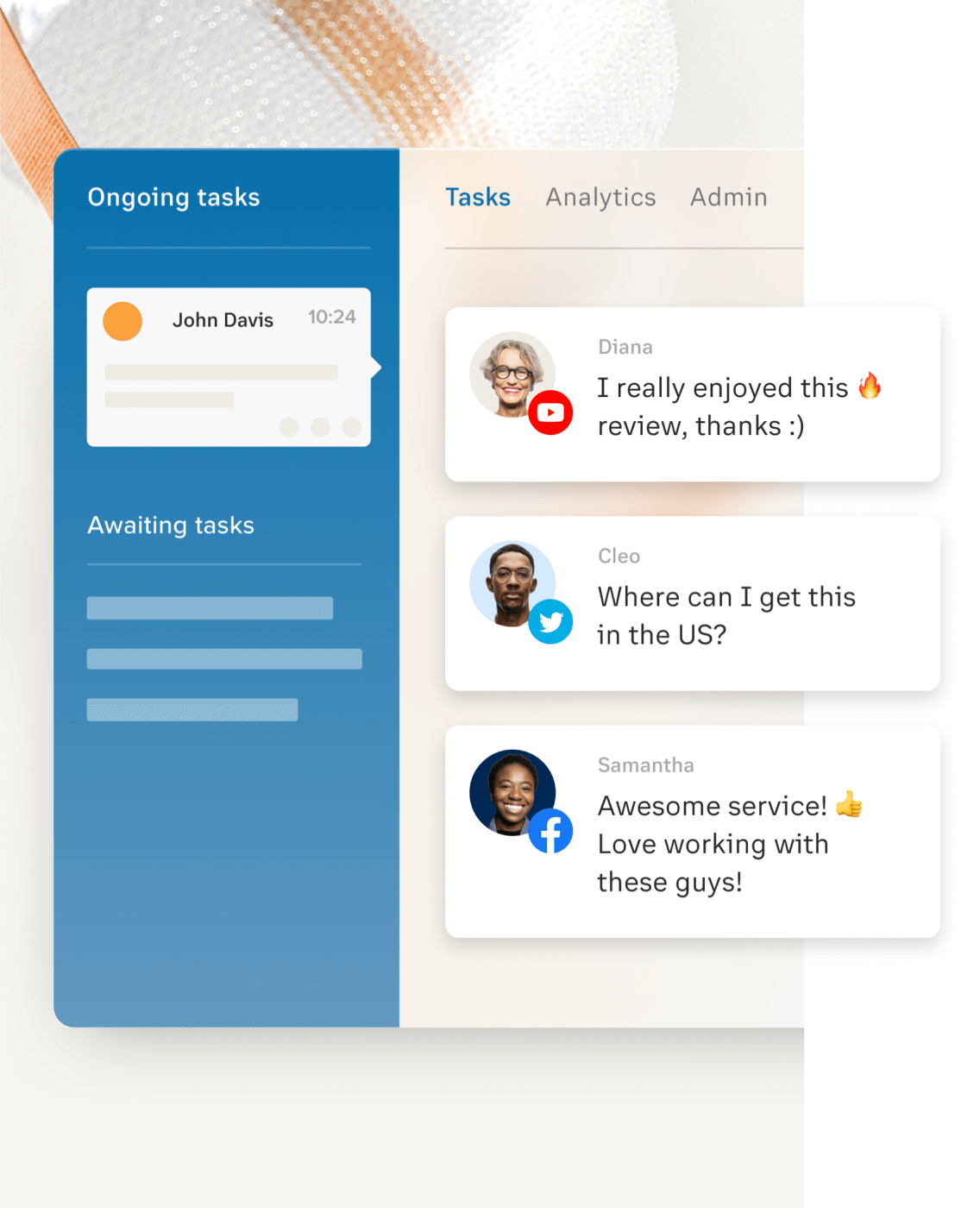If you’re looking for small business trends for 2022, you’ve come to the right place.
2021 was a(nother) year of challenges and change for small businesses. Lockdowns, remote and hybrid work, the Great Resignation: it’s all had a huge impact on the way we work.
The silver lining: throughout the upheaval, we’ve learned a lot about employee engagement, customer experience, and more. And we’re passing that knowledge on to you!
Here are 10 trends that we expect to see in 2022 plus practical ways your small business can hop on them:
5 employee experience trends for 2022:
- Employees will still expect remote and hybrid work options
- Employees will need more human connection
- Employees will seek better work-life balance
- Burnout isn’t going away, and it needs to be treated
- Internal employee development will be key
5 customer service trends for 2022:
- Customers will be more environmentally conscious of their spending
- Customers will continue to spend more time at home
- Customers will expect their favorite small businesses to be online
- Customers will make even more purchases via mobile devices
- Customer experience will be more important than ever
📊 Want even more small business trends? Grab our 2022 state of human connections at work report.
5 employee experience trends for small businesses in 2022
With a great team of employees, a business can thrive and grow. However, if your team is burnt out and understaffed, you can’t expect the same results. For a small business, even just one employee quitting for better opportunities can throw everything off balance.
You need to make sure you are taking care of your employees so their needs are met and the work culture stays positive.
With 2021’s Great Resignation, employees are reconsidering their priorities in life and how they can achieve greater happiness. This is a driving force for many of the trends we’ll likely see in 2022.
1. Employees will still expect remote and hybrid work options
The 2020 pandemic has given many employees the opportunity to work from home or remotely during shelter-in-place orders. And with the unpredictability of the 2021 Delta variant, many employees continued to work remotely or had to work from home when their children or family members felt ill.
Employees have come to enjoy the flexibility that remote work has given them. And for those that need in-person collaboration, a hybrid work model with some days of in-office work and the rest of the days remote has been a solid solution.
One of the perks for remote and hybrid work is all the time freed up from commuting to the office—some saving several hours a week that would have been spent in a car or public transportation. Employees spent this extra time with family, learning new skills, or doing what they enjoy. Businesses have also benefited by saving on smaller office spaces or eliminating their office.
Employees who thrive in a remote environment don’t want to give this up. RingCentral’s research found that 55% of employees expect a hybrid work environment going forward. And according to a survey of 10,000 US employees, more than 40% would start looking for a new job or quit if they have to return to a full-time office environment.
How to get in on this trend
Although remote or hybrid work isn’t a perfect fit for many industries and businesses—it’s not realistic for a bartender or a plumber to work from home—it’s still possible for many small businesses.
To get started, employees need to be able to take their work with them. There are lots of cloud communications software options out there that can help any size business get their remote and hybrid workforce connected. You should look for a platform that rolls all of your communications into one easy-to-use app. For example, with RingCentral, your team can hop from messaging to a video conference to a phone call with just one click:

This all-in-one approach means no important conversations get lost in the shuffle. Plus, it saves time toggling between apps, which can mean money lost and frustrated employees.
2. Employees will need more human connection
One problem that stems from remote and hybrid work is the lack of human connection. It has been well documented for years that humans need social interaction for their mental and physical health.
In a survey by RingCentral, 39% said that hybrid and remote working made them feel more lonely and isolated. And 57% of employees have not met their coworkers due to the pandemic and working remotely.
When an employee is working alone with only disembodied voices coming from their speakers and streams of text appearing on their screen, it is easy to see how isolating this kind of work can be. Employees need to feel connected to feel happiness at work, and employers must do something to alleviate this.
How to get in on this trend
For companies with a full remote workforce, connecting with coworkers can be difficult but not impossible. To establish human connections, you need to, well, act human.
In team video meetings, you don’t need to get straight into business talk. Start off your meetings with a fun prompt like “What was your favorite food growing up?” or “If you had a superpower, what would it be?” This will allow your team members to speak up and get to know each other.
Also, create a work culture where everything is not always about work. With RingCentral MVP™, you can use the platform to message a coworker with a funny animated gif. Use the phone function to chat up a work friend during lunch. And have everyone on your team turn their cameras on to prove that there are humans behind the camera.

3. Employees will seek better work-life balance
Although more employees are working from home or remotely, it doesn’t mean that their work-life balance has improved. In many cases, the boundary between work and home life has been blurred. Employees are working more off the clock and during their personal time. One study found that remote workers are spending 2.5 more hours each day at work.
Work-life balance is not just a US problem. In November 2021, the Portuguese parliment approved a law that employers can’t contact employees after work hours.
When workers feel like they are working more than living, they are more likely to look for opportunities elsewhere or burn out. This is neither good for your business or employees.
Companies that establish a good work-life balance culture will be more productive and retain more of their workers.
How to get in on this trend
Creating a good work-life balance for your employees requires a culture change for many small businesses. Business owners and managers can start setting an example by not contacting employees after business hours. In return, they would also discourage employees from contacting them once work ends too.
Another way businesses can improve work-life balance is being more lenient on employee time off. When employees need to take care of a sick family member or attend to an emergency, they shouldn’t be in fear of losing their jobs. Think about what you’re able to reasonably offer to keep your doors open and employees feeling supported.
One way RingCentral allows employees a break during the day is the “Do not disturb” status on the RingCentral app. Employees can mark their status with “Do not disturb,” and message notification pop-ups will not appear. If someone does contact the employee, the messages will still be there, but the employee doesn’t need to review them until they are ready to look at them:

RingCentral’s “Do not disturb” option silences notifications but keeps messages unread for when you’re ready.
4. Employee burnout isn’t going away, and it needs to be treated
Burnout among employees has always existed. And this is not just isolated to certain industries or company sizes. However, the stress from the pandemic has exacerbated the problem. Research found that 53% of workers feel burnt out.
When employees are burnt out, that means they have reached a point of exhaustion. They will be less productive, often feel cynical towards work, and may even quit. This is definitely not a good thing for businesses since turnover can cost them thousands per employee lost.
Businesses need to look out for their employees since it’s not sustainable or ethical to keep burning out workers. Burnout takes a toll on both physical and mental health. The World Health Organization and the International Labor Organization attributed 745,000 deaths from stroke and heart disease to overworking.
How to get in on this trend
Burnout can be caused by many factors. For your business to start healing burnout, you need to find what the causes are by getting honest feedback from your employees. You can use an anonymous survey or hold one-on-one video meetings to see how you can improve employee sentiment.
The cause may be poor work-life balance. In this case, consider if a four-day work week works for your business. In one study, 83% say that a four-day work week would reduce burnout.
Another thing that can lead to burnout is a toxic work environment. No one feels motivated to do their best if they are undermined, harassed, or bullied every day. If this is a problem at your company, find the source and make changes right away.
A lesser known cause of burnout is employees feeling a lack of control. This can be employees not being able to control their schedules or workload. It may also be a lack of clear expectations or resources. Whatever it is, talk to your employees and make an effort to improve their situations.

5. Internal employee development will be key
The idea that employees will stay with a company for years is becoming a thing of the past. While employers are doing what is best for their bottom line, employees also have to think what is best for them. In 2021, 51% of small business owners had trouble filling job openings.
So with many workers leaving companies and small businesses struggling to fill open positions, what can you do to keep the employees you have? Train your employees with new skills and promote from within.
Although training your employees with new skills sounds like a risk if they leave your company, it’s still worth it. The American Society for Training and Development found that companies that invested in training had a 24% higher profit margin. Employees who feel like they have room for growth within the company are also more likely to stay and perform better.
How to get in on this trend
Talk to your employees one-on-one and see what skills they are interested in learning that could help your business. Also see what skills they are lacking that can help them with their current jobs. Get to know what their career aspirations are.
After getting feedback from your employees, figure out a way to provide the training to them. Can you or another employee do the training? Does your budget allow for employees to attend classes? Can you lessen the workloads for employees so they can learn new skills during work time? Plan out how you can best train your workforce.
Also, think about your employees’ career paths. For example, a new employee can go from a cashier to a team lead to a store manager. Make these career paths transparent for your employees so they can see their room for growth within your company.
5 customer service trends for small businesses in 2022
While 2022 will be a lot about taking care of your employees, you also need to think of what your customers want too. Customers today are well aware of current events and are hoping for a better future. They are also very tech savvy and expect small businesses to keep up.
If you want to keep your existing customers and attract new ones, keep reading to learn what’s trending.
1. Customers will be more environmentally conscious of their spending
Global climate change has been a hot topic in 2021, and more customers are considering the environment when they make their purchases. In a 2019 global survey, 35% said they would choose to buy sustainable products. In 2021, that percentage rose to 50% of customers being more eco-friendly. With this trajectory, it would be no surprise that customers would choose environmentally conscious companies over ones that are not.
Besides attracting customers, small businesses can save by reducing their energy and consumption. For example, LED light bulbs use up to 90% less energy than incandescent light bulbs. LED bulbs also last much longer. If you have an office full of outdated lights, you can save on your energy bill by switching to more efficient LEDs.
How to get in on this trend
Going green for a small business can seem overwhelming, but start out small first. See what things you can eliminate or replace to be more eco-friendly. Instead of snail mailing paper invoices to your customers, you can send them an electronic copy over email.
You can also see if your county or city has a green certification program (here’s Santa Clara County’s program in Silicon Valley). If you meet the program’s requirements, your business can be officially recognized as being green. And some may qualify you for rebate programs too!
Also, be conscious of the source and materials of your products, services, and packaging. Can you source materials that are more sustainable and reduce or reuse what you already have?
After your environmental overhaul, don’t forget to show off your green initiatives so customers are aware. Include your efforts on your website (here’s an example from RingCentral), packaging, and descriptions. You can also keep customers regularly informed of your commitment to sustainability with regular social media and blog posts.
2. Customers will continue to spend more time at home
Since it appears that remote and hybrid work isn’t going out of style, more people will be at home than before the pandemic. This is affecting how people make their purchases and spend their money. The statistic of Amazon adding 209,000 warehousing and transportation jobs from July 2019 to July 2021 shows that online purchasing is up.
Some purchases that were up in 2021 were home improvement projects and activities that people can do at home, such as cooking and hobbies.
People also want to get out of their homes after being cooped up. 72% of US travelers said they want to travel more in 2022.
How to get in on this trend
To make this trend work, you may need to reconsider your business model. Think about how your products or services can benefit people who are working from home. Do you make it easy for customers to make purchases or appointments online?
Also think about how your services can be more convenient for customers who are working remotely. Same-day delivery or service that comes to the customer can boost sales. With RingCentral, it is possible for an auto mechanic to become a mobile service that comes to customers’ homes. Phone calls that are made to the office can be sent to your cell phone when you are out. You can also make calls and send texts from your personal phone with your business number, and even switch between devices during meetings:

3. Customers will expect their favorite small businesses to stay online
The pandemic lockdowns showed businesses and customers alike what was possible when it comes to online customer service. Businesses had to pivot, and customers will continue to expect the convenience they’ve grown to enjoy from online access to their favorite brick-and-mortar shops. This could be for online ordering, scheduling service, and even telehealth appointments for small medical practices.
More customers are online than ever before. Many adults who haven’t made online transactions before started using them after the pandemic started. Since customers want your business to fit with their needs, they expect you to have an online presence that’s helpful and functional.
It is also very beneficial for your business to have a website. Your existing customers can see what your hours are or get updates on your business. And new customers can discover your business online. If you aren’t online, they may never know your business exists.
How to get in on this trend
If you have to start your web presence from scratch, start off with a Google Business Profile. This would make your business easier to find in online searches by location. You can also update your contact information and hours.
Another way to get started is with social media like Facebook, Instagram, Twitter, and LinkedIn. These are free to sign up and easy to set up in one day. However, for your social media to be effective, you should have a regular post schedule so your customers don’t forget about you.
And in the future if your social media is blowing up with messages from customers, check out RingCentral Engage Digital™ to make sure you respond to every customer’s inquiry. This customer experience arm of RingCentral puts all of your external communications in the same place… yes, even Facebook messages!

And now for the scary part: it’s about time you set up a website. The good news is that building a website is easier than ever. You don’t need to know how to code, and there are many website builders with templates that can help you out.
4. Customers will make even more purchases via mobile devices
Buying something online with a phone or tablet has been gaining popularity over the years. In 2022, mobile purchases are expected to grow by 68%.
Phones are convenient, and customers can take them anywhere. The newest phones may also be faster than your desktop or laptop computer! All this ease of use makes customers more likely to use their phones.
If you ever used your phone to look at a website and an image was too big for the screen or it was impossible to click on a link, you know that the business wasn’t thinking about their mobile customers. As a small business, you will need to make sure your website is easy for mobile customers to view and use.
How to get in on this trend
If you are using a website template, your job of making your website more mobile-friendly will be a lot easier. Many of these templated website builders have an option to view the screen with a mobile or tablet view. So even if you don’t have a smartphone or tablet, you can view what your customers are seeing.
When you are viewing your website in the mobile-responsive view, explore your website and click around. Does everything still work as expected? You may need to change up your settings in the mobile view so customers have a good experience navigating your website on their mobile devices.
If you don’t know anything about how your website is set up, it would be worth investing in an expert to get your website mobile-ready.
5. Customer experience will be more important than ever
Supply chain shortages are expected to last well into 2022. This means things from microchips to ketchup packets may be in short supply for a while.
When customers can’t find what they want at one business, they will try to go to another. But when all competitors are missing what customers are looking for, how can a business stand out?
Forrester predicts that in 2022, customer experience will be a huge differentiator for businesses. In their survey, they found that many businesses that improved their customer experience during the 2020 pandemic also improved their brand loyalty and likeliness that customers would make repeat purchases.
With many key materials or products not available, customers will be trying to contact businesses to get more information or updates. Your business will need to keep up to provide an excellent customer experience, even if you don’t have what they are looking for. Customers will more likely remember you when supplies are back in stock.
How to get in on this trend
Customer experience is where small businesses can really shine… and compete with even the biggest box stores. Why? Because it’s all about personal touches and making every customer feel seen, which can be harder for larger companies to handle.
Make it easy for customers to contact you. This will mean you will have to consider all the ways your customers may be trying to contact your business. They may be trying to reach you by phone, email, text messaging, or social media channels. And the faster you respond the better. 58.9% of customers expect a quick response.
You can simplify how you handle your customer experience with contact center software. If you are overwhelmed with customer questions coming from all directions—text, chats, Facebook, Twitter, Instagram, and more—RingCentral Engage Digital makes this easy. Engage Digital merges all of these inquiries so you don’t miss a single message.
Software like RingCentral’s inbound contact center solution also makes it easy for customers to reach the best person to help them. You can set up your call routing to specific departments or by availability.
And don’t forget about self-serve help. Provide your customers with a list of frequently asked questions on your website. You can also keep your customers informed of updates—like a new shipment of products—on your social media.
2022 small business trends: Which ones are right for you?
Employees and customers are a central theme for 2022. Employees are looking out for their best interests. You will need to think about what is best for your employees as well as your business. Happy employees often means happy customers.
Customers also have their needs and wants. You will need to take these into consideration too. This may mean making investments and changes to how your business is run.
No one knows what unexpected challenges will come in 2022, but if your business is resilient, you will be able to bounce back stronger than ever.
Originally published Dec 09, 2021, updated Nov 08, 2023




